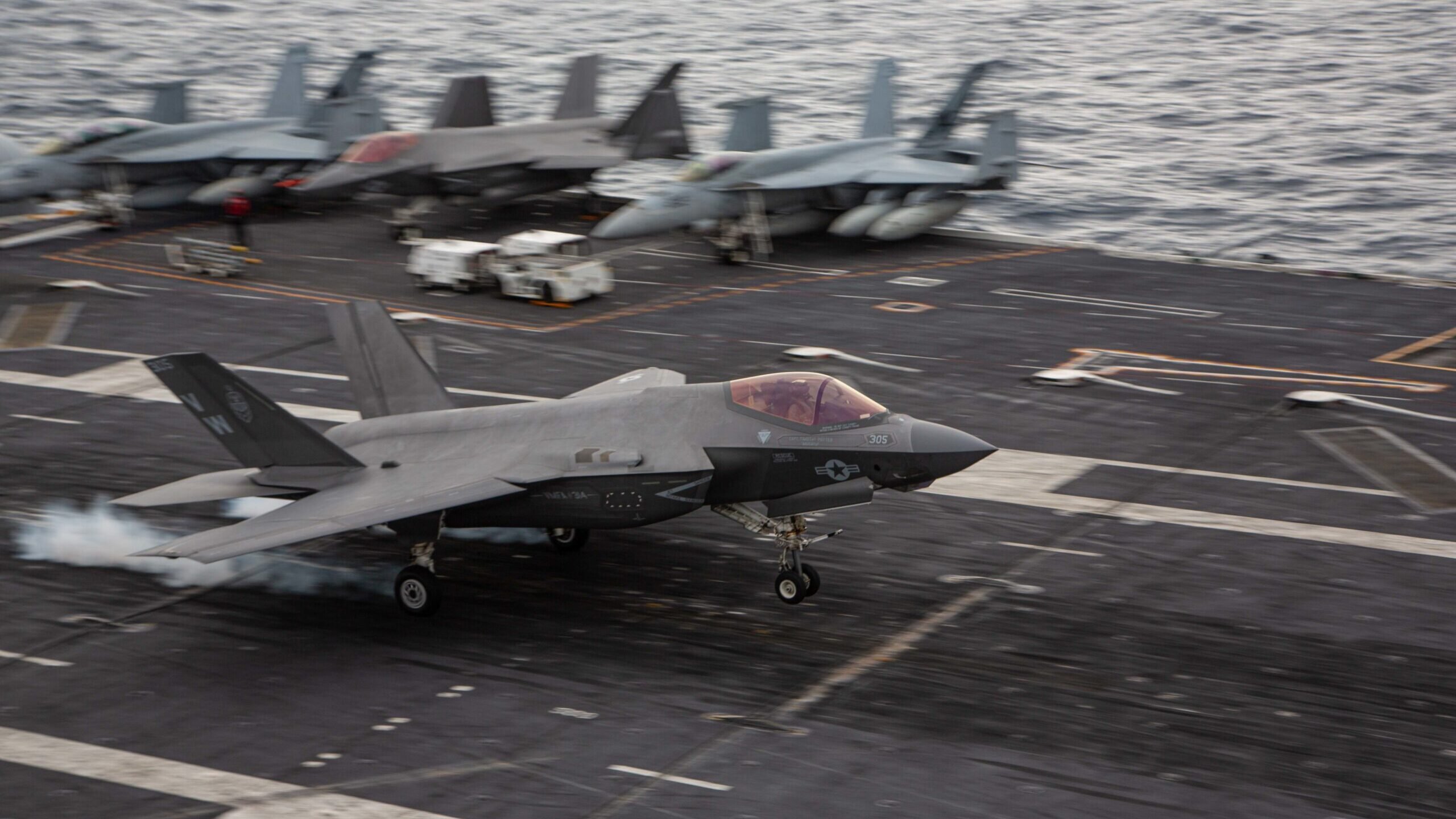
An F-35C, assigned to Marine Wing Fighter Attack Squadron (VMFA) 314, launches from the flight deck of the aircraft carrier USS Abraham Lincoln (CVN 72). (US Marine Corps/1st Lt. Charles Allen)
WASHINGTON: The latest version of the fiscal 2022 defense policy bill hammers the F-35 program, imposing cost constraints and forcing the Pentagon to release control of the program to the military services by the end of the decade.
The new FY22 National Defense Authorization Act, which was passed by the House on Tuesday night and is most likely the final version of the bill, marks a sea change for Congress with regards to the notorious stealth plane.
Lawmakers have typically argued for increases to F-35 procurement, even as they sought more information concerning the program’s cost and schedule. This year, however, legislators have sunk their teeth into the program, inserting language that could clamp down on procurement of the jet post-2028.
The NDAA blocks the US Air Force, Navy and Marine Corps from buying the full number of F-35s planned in current programs of record unless the cost of sustaining the jet meets the services’ self-defined targets.
Specifically, the legislation revolves around the “cost per tail per year,” which measures the average cost of flying, maintaining and upgrading an aircraft, as well as the manpower associate with those activities.
The services have until Oct. 1, 2025 to come up with updated cost per tail per year targets for FY27. However, if a service misses that objective after Oct. 1, 2028, the number of F-35s that can be procured or operated by the service could be proportionally curtailed.
The language originated in the House Armed Services Committee’s version of the bill, and is intended to induce Lockheed Martin and Pratt & Whitney — which build the F-35 air vehicle and engine, respectively — to lower the costs of operating and maintaining the aircraft, HASC Chairman Adam Smith said in August.
“If you bring the sustainment cost down, we’ll buy more,” said Smith, D-Wash. “If you don’t, we’re not going to, simply because of the cost that is involved in that.”
The bill also imposes a deadline for the F-35 Joint Program Office to hand over authority for modernizing and sustaining the F-35 to the Air Force and Navy, leaving the ultimate fate of the program office unclear.
According to the proposed legislation, the JPO must transfer all sustainment activities for the F-35A to the Air Force by the start of FY28, with the department of the Navy becoming the sustainment authority for the F-35B and C variants at the same time. In addition, the JPO must relinquish all F-35 acquisition functions to the Air Force and Navy by the beginning of FY30.
The Pentagon has until Oct. 1 to develop a plan laying out how the JPO will transition its responsibilities to the services, the NDAA states. However, the language does not make clear whether the JPO will remain functional as a hub for the F-35’s international customer base, which currently includes more than a dozen countries, or to perform other administrative functions related to the Pentagon’s largest weapons program.
Finally, the bill calls for the Pentagon to investigate the functioning of all fighter aircraft with Onboard Oxygen Generation Systems, or OBOGS, an alternative to liquid oxygen that produces oxygen for pilots using bleed air from the engine. The department is also required to fix any OBOGS-related technical problems, starting with the issues laid out by NASA in a Nov. 2020 report. Such issues are thought to contribute to symptoms of oxygen deprivation in pilots, including five incidents reported by Air Force pilots at Luke Air Force Base in May and June 2017.
In addition to those legislative provisions, the bill lays down requirements for the Pentagon to submit a number of reports on the F-35, including:
- An acquisition strategy for outfitting the F-35A conventional takeoff and landing model with an adaptive engine starting in FY27, and a similar plan to upgrade the F-35B short takeoff and landing variant and F-35C carrier variant with a more advanced engine.
- A mandate for the Pentagon’s comptroller general to conduct an annual review of F-35 sustainment efforts for the years 2022 through 2025, including providing input on what the Pentagon could do to reduce the cost of maintaining the aircraft.
- Language that prevents the department from entering a performance-based logistics contract for F-35 sustainment unless the defense secretary certifies that the agreement will cut costs or increase readiness and provides a cost-benefit analysis comparing the performance-based logistics deal with legacy contracts.
UK picks 90 suppliers to support Hypersonic strike program
The various suppliers were all picked to join a Hypersonic Technologies and Capability Development Framework (HTCDF) agreement, making them eligible to compete for eight lots worth a maximum value of £1 billion ($1.3 billion) over the next seven years.


























